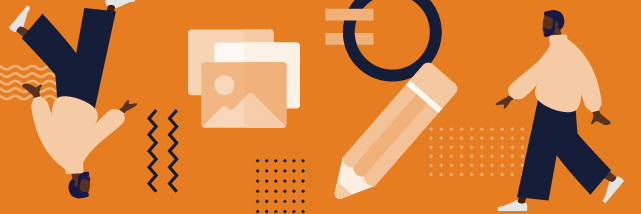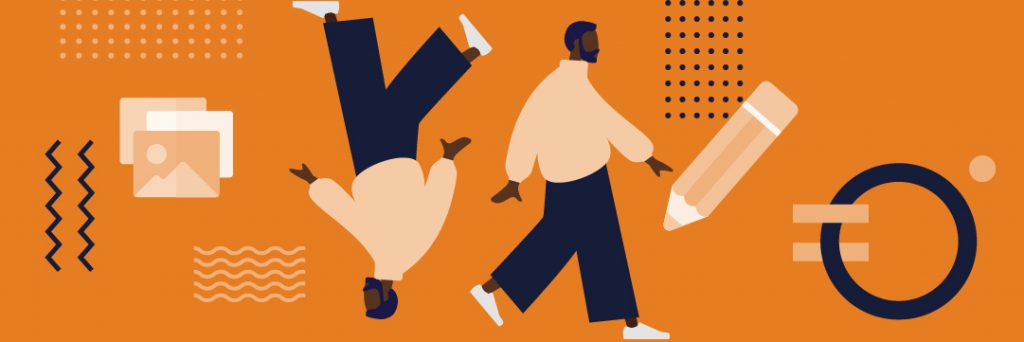I’ve said this many times, and I’ll say it again: humans are primarily visual creatures. That’s a part of our primate heritage that we can’t quite get out of. If you think about it for a second, it’s no wonder that so many media projects rely on pictures to get points across. An illustration is a great way to simplify, clarify, and enunciate where words fail. Today, we’ll learn a little bit more about the topic, as well as where to find amazing illustrators for your projects.
So, What’s an Illustration?
You’d be surprised at how many people think that ‘illustration’ simply means “drawing”, or “explanation.” While both of these hold parts of the truth, the reality is more of a composite.
I’ll let our pal Wikipedia do the explaining on this one:
An illustration is a decoration, interpretation or visual explanation of a text, concept or process,[1] designed for integration in published media, such as posters, flyers, magazines, books, teaching materials, animations, video games and films
Of course, it’s up to talented illustrators to bring these to life. They don’t only have to be great artists, but also great visual interpreters. The whole point is to use visuals as shorthand, not the other way around; their art clarifies, it doesn’t obscure.
So, It’s Not Just Drawing?
That is still the primary form of illustration, yes. But, nowadays there are many ways to convey things visually. Contemporary styles of illustration use a wide array of techniques beyond just sketchin’. Let’s take a look at some below:
- Drawing, as we’ve gone over above.
- Painting
- Printmaking
- Collages
- Montage
- Digital Design
- Multimedia (combining different content styles, such as text, video, images in a single presentation)
- 3D Modeling
And, of course, any combination of the above. As you can see, the world of illustration can be pretty varied. It’s not all about coloring within the lines, heh.
What’s It For?
Ok, we’ve established the techniques that can be used for illustration. As wide as the range is, the amount of specialist illustration areas is even higher. You can’t say there are few career opportunities here:
- Architectural illustration
- Archaeological illustration
- Botanical illustration
- Concept art
- Fashion illustration
- Information graphics
- Technical illustration
- Medical illustration
- Narrative illustration
- Picture books
- Scientific illustration
Technical and Scientific Varieties
If there’s one area where the simplicity of illustration really shines, it’s here. Science is not exactly a straightforward business, nor is science communication. The use of images in this case can help clarify what would otherwise be complex, challenging information. By using visual cues like cutaways, exploded views, diagrams, and others, you can convey information through the visual channel. This aids understanding, retention, and ultimately leads to better results than just a wall of text.
Technical illustration also serves as a way to communicate scientific concepts to the general public. Laymen and a non-technical audience sometimes take an interest in science. It’s essential to be able to relay information in a way that’s both accurate and engaging for education purposes. If not, you risk losing your audience or, even worse, disseminating wrong or incomplete information. Oversimplifying to the point of losing important bits is also a big issue that needs to be tackled head-on.
Illustration as Art
Now, we’ve established that illustration is used “for” something. But, as with many things that began as technical disciplines, it also has its own value and merit as an art form. While the hoity-toity world of art used to turn up its nose at illustration, deeming it of a lower caste than graphic design and fine art, something for the hoi polloi, things are changing.
How so? Mainly through the introduction of new art forms like video games, graphic novels, and other visually-arresting mediums. Who would’ve thought that all on its own, illustration would also become a global market?
Today, illustrations by well-known artists can sell for a pretty penny. Also, critics see art for video games and other mediums as being of high quality. The rift between the technical and the artful has never been more blurry.

What’s It All Mean For You?
Say you’ve got a new video game project in the works, for example. As much as you’d like to start codin’ and get goin’, it’s not quite so simple. You need a technical team, however small, that usually starts with concept artists and illustrators. You may have a rough idea of how you want your characters, backgrounds, environments, and items to look, sure. The thing is, “It’s got big arms and small, pointy head” is not much for 3D modelers to go on. Who is going to all of your great ideas onto a page or Wacom for other departments to work on? You’ve guessed it: illustrators.
And that’s not all: as you’ve seen above, there are many technical disciplines in illustration. In the world of gaming, GameDesign.org lists:
- Concept Artist
- Environmental Artist
- Character Artist
- Character Animator
- FX Animator
- User Interface Artist
- Marketing Artist
- Level Designer
- Art Director
That means that for any given project you’ll probably end up hiring many illustrators, or a few talented jacks-of-all-trades for smaller projects. This, of course, it’s not just about video games but illustration in general. You can transpose the general principles of this example to many other mediums. Movies, animation, websites, fashion, etc., adhere to the same guidelines. There are plenty of sub-specializations, so you need to keep your eyes open. While you can find “Swiss knife” illustrators, you’ll often be better off with specialists.
The main takeaway is that you won’t get a media or multimedia project off the ground without illustrators. See those cute little images peppered around this post? Here at Bunny Studio, we know this well.
Where do I find ’em?
Lucky for you, it’s pretty easy to find illustrators online these days. Out of all the specialties related to graphic designs, it’s one of the few with a more abundant talent pool. Of course, this merits a warning: large quantities don’t frequently overlap with quality. You’ll have a vertigo-inducing degree of illustrators to choose from for your project, but few of them will be worthy. So, first off, how do you get started?
Your Options
Nowadays, you can go to graphic design studios or freelancing platforms. Both have their advantages and disadvantages. In general, studios tend to have more experienced illustrators, and freelancing platforms a far larger talent pool to choose from. This includes the lower rungs of the ladder, but also superstar talent and excellent “bang for your buck” pros. Studios usually have money-back guarantees and established staff, and freelancers can be a flighty bunch that can hold back projects if they’re not very solid or responsible.
Of course, this doesn’t make studios better than freelancers. Platforms like Upwork can circumvent this by having escrow payments. This is a protective measure where the hirer pays in advance, but the platform doesn’t release the funds to the pro until the job has been completed satisfactorily. Upwork and similar platforms also facilitate access to the cream of the crop of the illustration world, as well as some professionals that I’d hesitate to call anything but a steal.
As with everything, you’ll have to weigh your options. Consider what’s best for you and your project, and move ahead. Below, I’ll share some common-sense ideas for you to hire pros.
Provable Experience
Every professional worth their salt should have a great portfolio. This helps potential employers see not just their experience on a CV, but whether their art style and skills are up to snuff. It’s easy for someone to say “I’m a great match for your project,” but we need to think about the “Show, don’t tell” rule. You want your potential hires to have proven experience doing what they say they can do.
Having a page on Behance, samples, or other means of showing their stuff is an absolute requirement. Some so-called pros will want to get in the door by saying “Yeah, I can do that,” but you should always let their previous work be their calling card. It’ll save potential headaches later, and — most of all — it’ll help you see whether their illustration style is your cup of tea.
Try to Find Platforms That Do Away With the Guesswork
Some platforms like Bunny Studio help its users gain quick access to world-class talent. What’s the difference between this and other platforms? To wit:
- Vetted talent. Not just anyone can get on the platform, as is the case with other freelancing sites. Illustration pros need to pass certain tests before they’re admitted. We pride ourselves on being rigorous and accepting only top-level talent.
- Cool rates. You won’t find talent of this level at these rates. Our price/quality ratio is unmatched anywhere on the internet. Trust us, we’ve looked.
- Turnaround. Sure, you can hire great pros somewhere else, but what’s their turnaround time? Our platform ensures you get your illustrations back in a fraction of the time other freelancers or studios offer. What takes a week/weeks to others takes only 24-48 hours for the Bunnies.
- You have a QA team watching. Pros don’t just submit their results without us taking a good look at them first. We don’t send you the final product unless it meets our stringent quality standards.
- Satisfaction matters. If you don’t like the results, you should get your money back, and you will. If for some reason you don’t like the final illustration, you just let us know and we’ll refund 100% of the money.
If any of these sound good, I’d bet that the whole thing is looking pretty sweet right now. If you need illustrators, we’ve got the best around and we’re ready to prove it. We’ll we waiting when you’re ready to give us a call!










